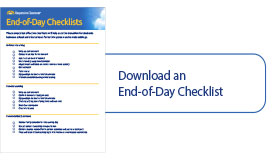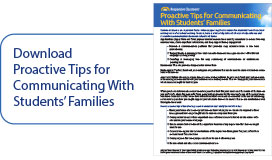
Prior to the pandemic, it is likely that we rarely gave much thought to how we transitioned from one setting to the next. We would switch seamlessly from our place of work and its responsibilities to a celebration with friends, and we knew intuitively the social and emotional skills needed to be successful in each setting. During the pandemic, however, we’ve become more conscious about transitions we make from one setting to the next, from places that require a mask and social distancing to places that do not. Adults will still have an understanding of the social and emotional skills needed to make a successful transition between settings under these new circumstances. For students, though, these transitions require conscious energy and effort as they consider what is expected of them in each new setting.
Nowhere is this truer now than in the transition from the school setting to the after-school setting. Whether attending class in person or virtually, this transition requires students to demonstrate and maintain a certain unique set of skills in order to function and communicate. According to the Collaborative for Academic, Social, and Emotional Learning, “Social and emotional learning is a deeply ingrained part of the way students and adults interact both in the classroom and out of it” (CASEL, n.d.). As students shift from their “school selves” to their “after-school selves,” they must make adjustments that require unique social and emotional skills and have an awareness of what is appropriate in each setting.
Supporting students as they practice this daily transition is critical and will be beneficial to their growth and success. Research shows that if we want students to succeed in school and in life, we need to promote their social and emotional skills in the classroom and as they transition to their lives outside of the classroom (Schonert-Reichl & Hymel, 2007).
Supporting the Transition From the School Setting to the After-School Setting
Students shifting from their school settings and selves to their after-school settings and selves have a number of things to consider. Here are ways that adults can support students make this transition, in both virtual and in-person learning environments.
Ways That Teachers Can Help
Educators can establish ways to stay in communication with after-school care programs and families to share expectations and routines that will allow staff or family members to check in with students and initiate helpful dialogue about the school day.
As the school day comes to a close, teachers can take time to model the thought processes and behaviors that students need for success. For example, they can encourage students to ask themselves questions such as:
- Are there any tasks I need to follow up on to help me end the day successfully?
- What do I need to do to wrap up for the day?
- In-person learning examples: wash hands, mask properly adjusted, have materials needed to complete assignments, coat, backpack
- Virtual learning examples: apps or programs closed down on the computer, logged out of accounts, confirm assignments needed to be completed
- What should I remember to do as I transition from my school self and setting to my after-school self and setting?
- In-person learning examples: say good-bye to classmates and teachers, mask stays on until I get home, remain socially distanced six feet from others
- Virtual learning examples: say good-bye to classmates and teachers, shut down the computer, clear my work area
Responsive Classroom practices such as reminding language (“What end-of-day tasks do you need to be doing now”) help students transition and provide a clear closing to the school day. According to CASEL (n.d.), employing practices that encourage and teach students skills such as self-awareness and self-management can produce positive outcomes for students.
Ways That Parents Can Help
To support the transition from the school setting to an after-school setting, parents can establish a schedule with their child that includes realistic and developmentally appropriate choices. Parents should also include unstructured time to allow students to wind down after a long day of learning before beginning structured tasks such as homework or chores.
Dr. Maureen Marshall, a former elementary school teacher and principal for over 25 years, points out that being proactive is yet another way to support the transition. “Always have a plan B,” says Marshall, who is also a mother of two. Her advice to parents is to be sure their child knows what plan B is when there is a change to their usual after-school routine. For example, an after-school doctor’s appointment can affect the schedule and change the time for activities such as completing their homework or the length of unstructured time. Parents should be sure to review alternate plans before they’re needed so that the child is prepared. Marshall also suggests that parents share or post their own schedule so their child can better anticipate changes that might occur as they transition from the school day (Marshall, personal communication, February 19, 2021).
Supporting the Transition From the School Setting to After-School Activities
Many things can occur at the end of the school day that make it difficult for students to successfully take on the responsibilities, activities, and tasks that follow. “You notice a lot of anxiety in students at the end of the school day, particularly students who have multiple things happening in the afternoons,” says Marshall (personal communication, February 19, 2021). Here are ways adults can support students making the transition from school to after-school activities.
Ways That Teachers Can Help
After-school activities, sports, and clubs will likely look different now than they did before COVID-19. Teachers can help by establishing proactive ways for students who engage in these activities to think about what they will need to do to prepare for them. Responsive Classroom practices such as Morning Meeting and Responsive Advisory Meeting can provide a platform for students to consider activities that follow after the school day. Using morning message during Morning Meeting and the announcements during Responsive Advisory Meeting can get students thinking about their responsibilities for after-school activities. You can encourage students to utilize the planners or agendas they use to record homework assignments to also record their activities or clubs for that day, along with the materials and items they’ll need.
Ways That Parents Can Help
Parents can spend time the night before reviewing and discussing the activities that will occur at the close of the next school day and any items that will be needed. They might consider posting a chart or calendar of the week’s activities that includes transportation plans and items their child will need. For example, an in-person activity may require students to wait in a specified location for social distancing and bring hand sanitizer. An activity that occurs virtually may require log-in information and space appropriate for the activity.
As a parent, Marshall recommends strategies that have worked for her daughters, who are involved in multiple activities throughout the school year. Preparing their equipment and materials for an activity the night before helps her daughters support their self-management skills by having them proactively think about what they may need. In addition, Marshall sends calendar invites and reminders to her daughters’ devices to help them remember the activities for the day. Older students can be encouraged to set their own reminders on a device or post their reminders on a calendar to support self-management skills (Marshall, personal communication, February 19, 2021).
Students receiving guidance on the skills to successfully navigate various settings are better able to make a seamless transition from their school day selves to their after-school selves. Just as importantly, these skills will extend to other parts of students’ lives and lead to greater success in and out of school.
References
- CASEL. (n.d.). What is SEL? The Collaborative for Academic, Social, and Emotional Learning. https://casel.org/what-is-sel/
- Schonert-Reichl, K. A., & Hymel, S. (2007). Educating the heart as well as the mind: Social and emotional learning for school and life success. Education Canada, 47(2), 20–25. http://www.jcsh-cces.ca/upload/Educating_Heart_Spring07-1.pdf


